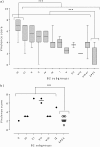Escherichia coli B2 Phylogenetic Subgroups in the Infant Gut Microbiota: Predominance of Uropathogenic Lineages in Swedish Infants and Enteropathogenic Lineages in Pakistani Infants
- PMID: 31562173
- PMCID: PMC6881811
- DOI: 10.1128/AEM.01681-19
Escherichia coli B2 Phylogenetic Subgroups in the Infant Gut Microbiota: Predominance of Uropathogenic Lineages in Swedish Infants and Enteropathogenic Lineages in Pakistani Infants
Abstract
Escherichia coli segregates into phylogenetic groups, with group B2 containing both extraintestinal pathogenic E. coli (ExPEC) and enteropathogenic E. coli (EPEC) strains. Ten main B2 subgroups (subgroups I to X)/sequence type complexes (STcs), as well as EPEC lineages, have been identified. In the current study, we characterized ExPEC and EPEC strains of E. coli B2 phylogenetic subgroups/STcs that colonize Swedish and Pakistani infants. Gut commensal E. coli B2 strains, 120 from Swedish infants (n = 87) and 19 from Pakistani infants (n = 12), were assigned to B2 subgroups. Carriage of the bundle-forming pili and intimin adhesin was examined in the EPEC lineages. The ExPEC virulence markers and the time of persistence of the strains in the microbiota were previously determined. In total, 84% of the Swedish strains and 47% of the Pakistani strains belonged to 1 of the 10 main B2 subgroups (P = 0.001). Among the Swedish strains, the most common B2 subgroups were IX/STc95 (19%), II/STc73 (17%), VI/STc12 (13%), and III/STc127 (11%), with each subgroup carrying distinctive sets of ExPEC virulence markers. EPEC lineages with few ExPEC features constituted 47% of the Pakistani B2 strains but only 7% of the Swedish B2 strains (P = 0.0001). The subgroup distribution within phylogenetic group B2 strains colonizing the gut differed between Swedish and Pakistani infants. B2 subgroups with uropathogenic characteristics dominated the gut microbiota of Swedish infants, while EPEC lineage 1 strains frequently colonized the intestines of Pakistani infants. Moreover, within the B2 subgroups, ExPEC virulence genes were more prevalent in Swedish strains than in Pakistani strains. Thus, ExPEC traits exemplify the intestinal B2 strains from Western populations.IMPORTANCE The intestinal microbiota is an important reservoir for bacteria that cause extraintestinal infections. Escherichia coli is found ubiquitously in the gut microbiota, and it also causes urinary tract infections, infantile septicemia, and meningitis. Urinary tract infections are usually caused by E. coli strains that originate in the intestinal microbiota. E. coli also causes gastrointestinal infections and is a major cause of diarrhea in infants worldwide. The abilities of certain E. coli strains to cause infections are attributed to their virulence factors, i.e., bacterial components that contribute to the development of different diseases. Our study shows that different subtypes of potentially pathogenic E. coli strains dominate in the gut microbiota of infants in different geographical areas and expands our knowledge of the interplay between bacterial commensalism and pathogenicity.
Keywords: Escherichia coli long-term persistence; ExPEC; children; enteropathogenic; intestinal microflora; phylogenetic group B2; uropathogenic.
Copyright © 2019 American Society for Microbiology.
Figures



References
Publication types
MeSH terms
Substances
LinkOut - more resources
Full Text Sources
Medical

